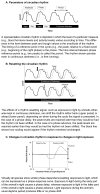Overview of circadian rhythms
- PMID: 11584554
- PMCID: PMC6707128
Overview of circadian rhythms
Abstract
The daily light-dark cycle governs rhythmic changes in the behavior and/or physiology of most species. Studies have found that these changes are governed by a biological clock, which in mammals is located in two brain areas called the suprachiasmatic nuclei. The circadian cycles established by this clock occur throughout nature and have a period of approximately 24 hours. In addition, these circadian cycles can be synchronized to external time signals but also can persist in the absence of such signals. Studies have found that the internal clock consists of an array of genes and the protein products they encode, which regulate various physiological processes throughout the body. Disruptions of the biological rhythms can impair the health and well-being of the organism.
Figures


References
-
- Aschoff J. Cold Spring Harbor Symposia on Quantitative Biology: Volume XXV. Biological Clocks. New York: Cold Spring Harbor Press; 1960. Exogenous and endogenous components in circadian rhythms; pp. 11–28. - PubMed
-
- Brunello N, Armitage R, Feinberg I, et al. Depression and sleep disorders: Clinical relevance, economic burden and pharmacological treatment. Neuropsychobiology. 2000;42:107–119. - PubMed
-
- Dement WC. History of sleep physiology and medicine. In: Kryer MH, Roth T, Dement WC, editors. Principles and Practice of Sleep Medicine. 3d ed. Philadelphia: W.B. Saunders; 2000.
-
- King DP, Takahashi JS. Molecular genetics of circadian rhythms in mammals. Annual Review of Neuroscience. 2000;23:713–742. - PubMed
Publication types
MeSH terms
LinkOut - more resources
Full Text Sources
